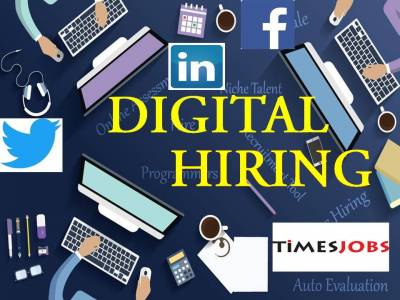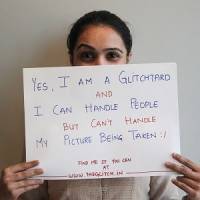Deep-dive: Digital hiring Part 1 – navigating the talent path
With digital media changing the way we consume content, shop, communicate and do much more, why should the way we look out for newer job opportunities be left behind. According to data released by the Society for Human Resource Management, in 2016, 54 per cent of the recruiters relied on Facebook; about 40 per cent of the companies used Twitter to source talent; 8 per cent used Google+ and YouTube; and 4 per cent used Pinterest to post jobs. Another study reveals that with 87 per cent of the recruiters using LinkedIn to seek the best talent available, social media has become an almost universally adopted hiring tool.
With most of the companies today switching to digital for recruiting talent, Adgully spoke to a cross-section of HR heads, online recruiters and a few young minds to know more about the entire hiring process in the digital world, the challenges and opportunities, what one should do and what needs to be avoided and much more.
Hiring in a digital age
Publicis Communications India has seen a tremendous shift in its recruitment sourcing pattern over the last 18 months, informs Surbhi Gupta, Chief Talent Officer, Publicis Communications India. She said, “While conventionally our people sourcing needs were fuelled by traditional sources, today, almost a third of our overall recruitment is done through digital sources. We connect with talent through multiple platforms including our website, social media, social forums; we don’t purely augment as a sourcing avenue, but also as a channel to build an employer brand and engage with passive talent by giving them glimpses of our world.” According to her, the constant pursuit is to find the right fit and social media helps them do that.While for The Glitch, about 60 per cent of its recruitment is done through digital portals and social media, while the rest is done through word of mouth and references. A sizeable amount of Rediffusion Y&R’s recruitment is also done through digital.
Saswati Sinha, HR Head at Cheil India, also shared that around 20-25 per cent of the agency’s recruitment process is carried out on digital. Gaurav Hirey, Group Director - HR & Talent Development, Teledirect Pte Ltd, said that currently over 45 per cent of Teledirect’s hiring is done through digital. “If you check how much of our hiring is through a digital touch point that number would be much higher than this one. Digital influences reach and helps us to reach out to not just active candidates but also passive ones,” he added.
The primary hiring platforms
Indiefolio, Behance, Super, LinkedIn, Facebook, and Twitter are among the major digital platforms that The Glitch experiments with, informs Unaiza Kadri, Head - Human Resources, The Glitch. On the other hand, Jennifer Sequeira, Deputy General Manager – HR, Rediffusion Y&R, refrained from revealing the names of the digital hiring platforms that the agency uses. Cheil India primarily uses Facebook, LinkedIn and sometimes Twitter while scouting for talent. Teledirect too looks at Linkedin and Facebook to scour for fresh talent. The company also gets a huge response to the online job listings on its careers website.
Publicis’ Surbhi Gupta observed that while the fundamentals of recruiting are still the same, their channels have seen an interesting move to digital and social platforms. She elaborated further by saying, “Apart from the regular social networking sites, we are exploring platforms that integrate traditional sources like employee referrals, to social. There are platform solutions available that integrate the employee referral process to social channels, thereby helping tracking and bringing in effectiveness and efficiencies. Something that traditional doesn’t offer. The internal recruitment platform also offers these integrations to LinkedIn, Facebook, etc. In this way, tracking and follow ups become easy and redundancies are reduced.”
The hiring conundrum – Digital Vs traditional
Batting for digital, Unaiza Kadri remarked, “You are able to see a person’s likes, interests, Grammar online by visiting their profiles and Twitter feed. A recruiter saves a lot of time in knowing whether a person will fit into the company, not just professionally, but culturally as well.”According to Saswati Sinha, social media is a gold mine for companies as they can get an easy access to a large pool of requisite talent. Among social media platforms, LinkedIn is the one used by maximum recruiters and organisations. According to DMR stats, 94 per cent recruiters today use LinkedIn to vet the candidate profiles. (http://expandedramblings.com/index.php/linkedin-job-statistics/), while the Society for Human Resource Management study states that 54 per cent of the companies use Facebook and about 40 per cent of the companies use Twitter to source talent. That’s why it is now called ‘social hiring’. The traditional model of job portals is a slow process in comparison to social hiring and it also does not attract the most appropriate talent.
“However, organisations like ours follow both new age method and traditional method to scout and hire,” Sinha informed.
“There is no comparison really,” said Gaurav Hirey. He pointed out that traditional hiring is all about placing adverts in newspapers, hiring internally or using the local employment agencies. While these avenues continue, they are not enough in the new age. If an organisation hires only through the traditional channels, there is a likelihood they are not getting the best candidates from the talent pool available out there. Digital hiring provides an exponential reach and is able to target specific groups based on the role, Hirey said, adding that it provides access to not just the active job seekers, but also to passive candidates who may get interested if they find the opportunity interesting. “Basically, leveraging digital hiring is a must for all recruiters and without including digital channels may make finding candidates a big challenge. Digital hiring provides exponential reach, helps in targeting candidates with specific skills and competencies, improves quality of hires due to its reach, is extremely cost effective and helps in creating an employer brand,” Hirey further said.According to Surbhi Gupta, the biggest benefits of leveraging the digital platform are the turnaround time and the cost advantage accrued. While the lead time from sourcing to closure is reducing, the hiring mandates are becoming more specific and targeted. Online platforms help in creating a strong, targeted approach. Passive candidates can be engaged through interesting and non-linear methods. It becomes imperative for us to tap into the larger talent pool and leverage our social networks to target the right candidate. The benefits of increased visibility and traction have increased efficiencies and effectiveness in hiring.
Jennifer Sequeira observed that digital profiles give easier access to applicant data, has better applicant turnaround time, is cost effective and additionally, since it is now a paperless process it saves time too.
The cost and time factor
“There is no doubt about the cost savings in terms of time taken to hire and cost per hire,” said Hirey. “More importantly, what digital impacts is the quality of hire, which adds more value to our businesses.”
Echoing similar views, Gupta commented, “The cost benefits are huge and we have completely moved away from engaging with talent partners unless it’s an extremely niche requirement, beyond the purview of our areas of specialisation. The time has come down by half in most cases and the stage of the process where we spend the time has also changed. We are able to spend more time engaging with passive talent and influence them instead of spending time creating a pipeline.”
“Since there is no overhead cost, this turns out to be much more affordable than a consultancy. But there is a lot more vetting that needs to be done to find that one perfect fit,” remarked Kadri.
Sequeira, too, said that a lot of time is saved due to this paperless process and this saved time can be better utilised for other significant HR strategies. “In today’s context, time is money,” he stressed. For Sinha, digital/ social media is more cost effective than traditional media if one factors in the time taken to source and convert talent. Digital medium also helps in increasing conversations and visibility. It opens multiple avenues to reach out to potential talent.
Changing face of recruitment
Gupta agreed that the recruitment process has undergone a massive change over the years for both the recruiter and candidates. “We now have multiple channels to source and hire from in the quest to build a strong and diverse team. The recruiter is not limited to sourcing or cold calling, databases, employee referrals, but is focused on connecting with talent across multiple platforms like Facebook, Twitter, LinkedIn, etc., all at the click of a button,” she added.
She further remarked, “Social platforms, too, are leveraging recruitment options and tools on their sites. There has also been a fundamental shift in mindset while approaching hiring. The pursuit is to identify people who fit not only into the role and come with the requisite skills, but also who fit into the culture and values of the organization and for us, that is the focus irrespective of the channels. Social media provides recruiters with an avenue to understand the interests of prospective employees, their LinkedIn activities, followers, etc. and provide a fair sense and understanding of candidates’ backgrounds and experiences.”
“We have moved from a traditional approach of naukri and monsters to a social one, where you open the job on social media and the word gets out immediately,” commented Kadri. There is not as much waiting time and the response is almost always immediate. This helps is a faster closure time and a higher outreach.
Sinha elucidated that earlier hiring process traditionally used to be about advertising through print, third party consultants or referrals. This would then help in collating profiles, shortlisting for interviews followed by final hiring. Now the entire process is much faster as organisations can directly connect with candidates through social media platforms, understand their profiles, interview through skype or video chat and hire the best talent. Amplifying their joining through social media also helps in building organizational reputation and motivating the new joinees. Thus more and more people (both candidates and recruiters now prefer social hiring!
Echoing similar views as Sinha, Hirey told that earlier hiring was more a role for recruiters and was done largely traditionally through adverts, employment agencies. Now its everyone’s role and everyone is involved right from building an attractive employer brand to ensuring that we get the best suited person to join our teams and our organisation. Today hiringis done leveraging multiple channels. It is done through leveraging social media, it is executed by creating below the line events like job fairs, career fests , it is now a 24x7 role , much more scientific with regard to selection of candidates and even uses artificial intelligence for evaluating potential employees. Talent acquisition teams are now the sales or marketing teams for the companies where attracting potential employee is concerned. It has gained so much importance that organisations are making talent attraction and acquisition an area of focus with even direct reporting to the CEO. All organisations today have realised that people are their final frontier and everyone is focused on getting the best talent available for themselves.
However, Sequeira is of the view that the more things change the more they stay the same – in the case of overall recruitment nothing can substitute acumen.
In the second part of this report appearing tomorrow (July 6, 2017), we shall look at how job portals are leveraging the business, as well as present the dos & don’ts for job seekers in the digital space.













Share
Facebook
YouTube
Tweet
Twitter
LinkedIn